Page 198 of 240
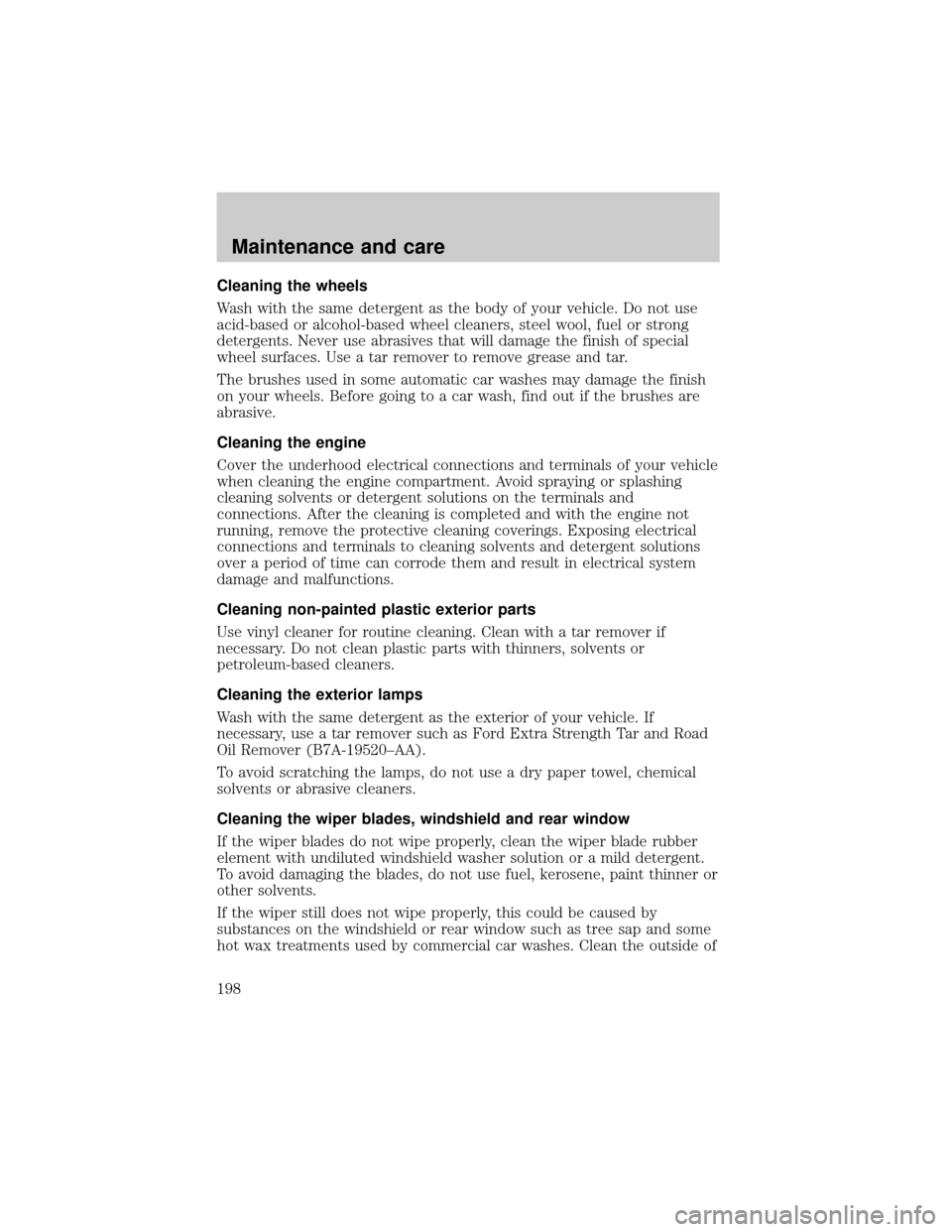
Cleaning the wheels
Wash with the same detergent as the body of your vehicle. Do not use
acid-based or alcohol-based wheel cleaners, steel wool, fuel or strong
detergents. Never use abrasives that will damage the finish of special
wheel surfaces. Use a tar remover to remove grease and tar.
The brushes used in some automatic car washes may damage the finish
on your wheels. Before going to a car wash, find out if the brushes are
abrasive.
Cleaning the engine
Cover the underhood electrical connections and terminals of your vehicle
when cleaning the engine compartment. Avoid spraying or splashing
cleaning solvents or detergent solutions on the terminals and
connections. After the cleaning is completed and with the engine not
running, remove the protective cleaning coverings. Exposing electrical
connections and terminals to cleaning solvents and detergent solutions
over a period of time can corrode them and result in electrical system
damage and malfunctions.
Cleaning non-painted plastic exterior parts
Use vinyl cleaner for routine cleaning. Clean with a tar remover if
necessary. Do not clean plastic parts with thinners, solvents or
petroleum-based cleaners.
Cleaning the exterior lamps
Wash with the same detergent as the exterior of your vehicle. If
necessary, use a tar remover such as Ford Extra Strength Tar and Road
Oil Remover (B7A-19520±AA).
To avoid scratching the lamps, do not use a dry paper towel, chemical
solvents or abrasive cleaners.
Cleaning the wiper blades, windshield and rear window
If the wiper blades do not wipe properly, clean the wiper blade rubber
element with undiluted windshield washer solution or a mild detergent.
To avoid damaging the blades, do not use fuel, kerosene, paint thinner or
other solvents.
If the wiper still does not wipe properly, this could be caused by
substances on the windshield or rear window such as tree sap and some
hot wax treatments used by commercial car washes. Clean the outside of
Maintenance and care
198
Page 202 of 240
Item Ford Part NameFord Part
NumberFord
Specification
Front axle spindle
pins, steering
linkage, front and
rear spring
shackle pins,
steering column
U-joints, steering
shaft slip yoke
and universal
joint, steering
shaft pillow block
bearing, clutch
linkage fittings.Premium Long Life
GreaseXG-1-C or
XG-1-KESA-M1C75-B
Bushings, front
wheel bearings
(grease packed
type)and seals,
fuel shut-off
solenoid linkage,
air brake control
valve, linkage,
treadle hinge and
roller,
transmission and
transmission
cables, clutch
release bearing
hub, transmission
shift lever pivot.Premium Long Life
GreaseXG-1-C or
XG-1-KESA-M1C75-B
Door
weatherstripsSilicone Lubricant F7AZ-19G208-BA
and
F5AZ-19553-AAESR-M13P4-A
DriveshaftU-joints
and slip splines,
power steering
gear output shaft.High Temperature
4 x 4 Front Axle
and Wheel Bearing
GreaseE8TZ-19590-A ESA-M1C198-A
Capacities and specifications
202
Page 203 of 240
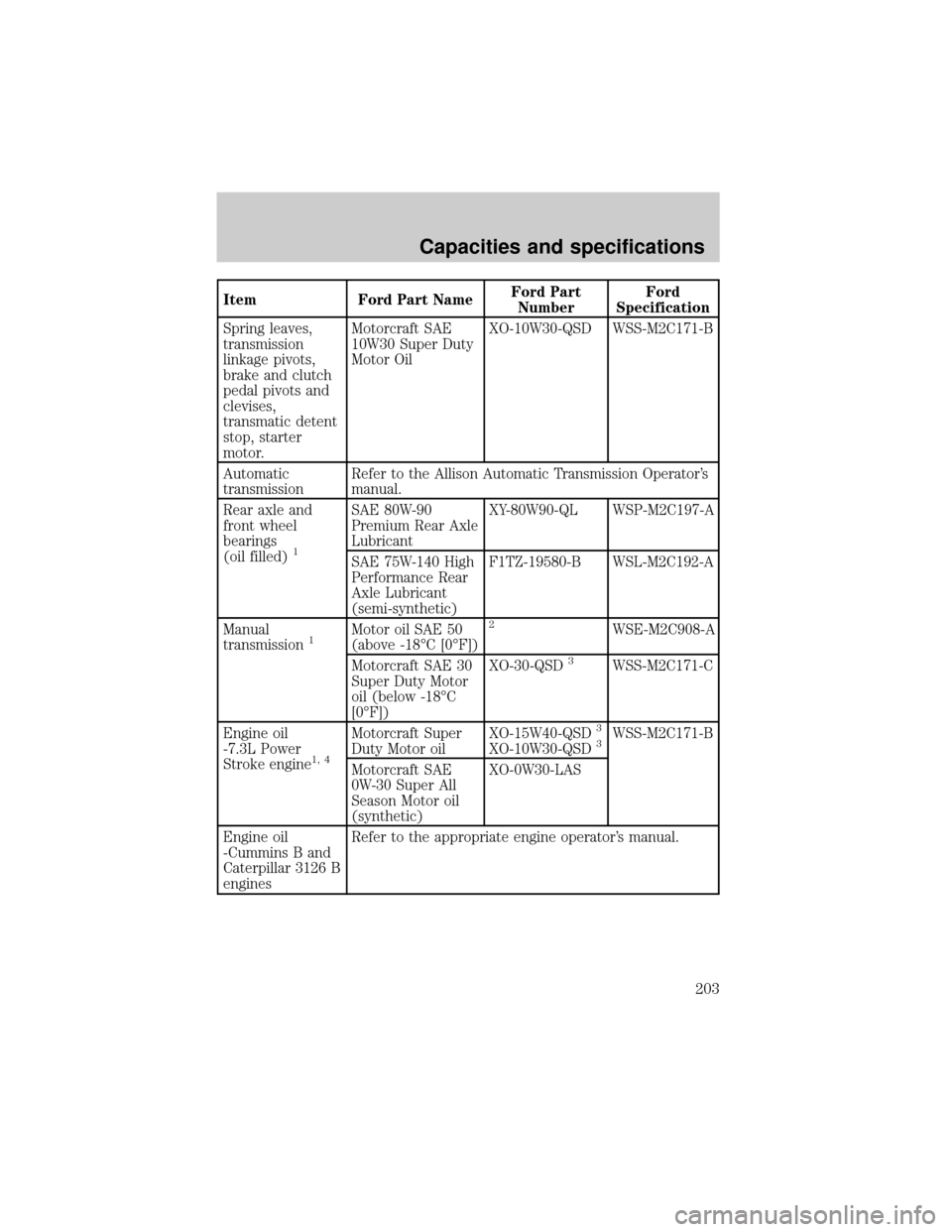
Item Ford Part NameFord Part
NumberFord
Specification
Spring leaves,
transmission
linkage pivots,
brake and clutch
pedal pivots and
clevises,
transmatic detent
stop, starter
motor.Motorcraft SAE
10W30 Super Duty
Motor OilXO-10W30-QSD WSS-M2C171-B
Automatic
transmissionRefer to the Allison Automatic Transmission Operator's
manual.
Rear axle and
front wheel
bearings
(oil filled)
1
SAE 80W-90
Premium Rear Axle
LubricantXY-80W90-QL WSP-M2C197-A
SAE 75W-140 High
Performance Rear
Axle Lubricant
(semi-synthetic)F1TZ-19580-B WSL-M2C192-A
Manual
transmission
1Motor oil SAE 50
(above -18ÉC [0ÉF])2WSE-M2C908-A
Motorcraft SAE 30
Super Duty Motor
oil (below -18ÉC
[0ÉF])XO-30-QSD
3WSS-M2C171-C
Engine oil
-7.3L Power
Stroke engine
1, 4
Motorcraft Super
Duty Motor oilXO-15W40-QSD3
XO-10W30-QSD3WSS-M2C171-B
Motorcraft SAE
0W-30 Super All
Season Motor oil
(synthetic)XO-0W30-LAS
Engine oil
-Cummins B and
Caterpillar 3126 B
enginesRefer to the appropriate engine operator's manual.
Capacities and specifications
203
Page 214 of 240

Daily Owner Checks Engine system
Check the air filter restriction indicator
Check the engine oil
Inspect the coolant level - for Powerstroke
engine (for Caterpillar and Cummins engines,
refer to the Owner's Manual)
Brake system
Drain the air brake system reservoir - manual
valve
Check the air brake system reservoir
automatic drain valve operation
Transmission system
Visually check the automatic transmission for
fluid leakage
Steering system
Check the power steering pump fluid level and
check the system for leaks
Check the entire vehicle for evidence of fluid
leaks
U.S. Department of Transportation,
Federal Highway Administration
requirements (ensure that the entire
system is functioning properly)
Check the service brakes
Check the parking brake
Check the steering mechanism
Check the lighting devices and reflectors
Check the tires
Check the horn
Check the windshield wipers
Check the rear vision mirrors
Check the wheels and rims
Check the emergency equipment
General maintenance information
214
Page 216 of 240
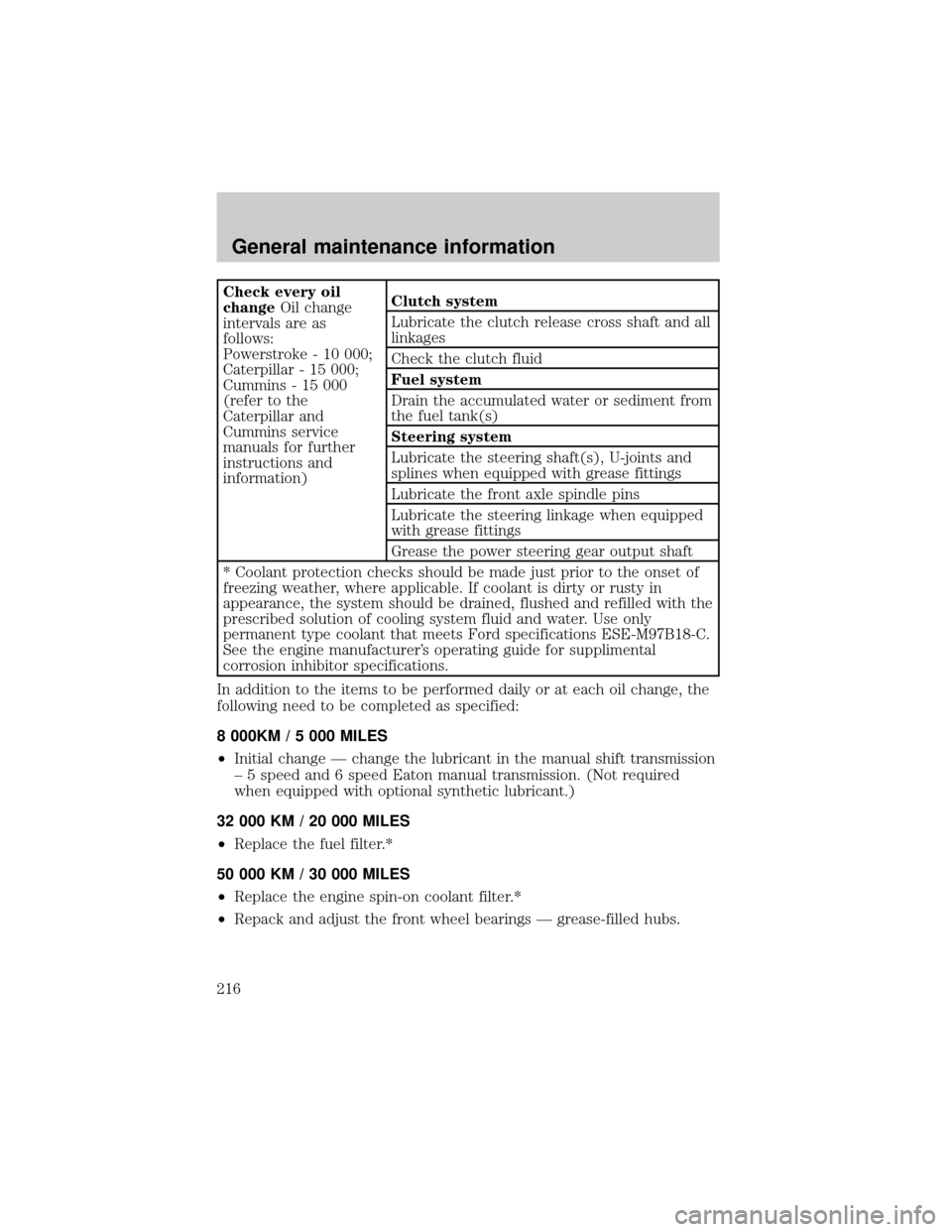
Check every oil
changeOil change
intervals are as
follows:
Powerstroke - 10 000;
Caterpillar - 15 000;
Cummins - 15 000
(refer to the
Caterpillar and
Cummins service
manuals for further
instructions and
information)Clutch system
Lubricate the clutch release cross shaft and all
linkages
Check the clutch fluid
Fuel system
Drain the accumulated water or sediment from
the fuel tank(s)
Steering system
Lubricate the steering shaft(s), U-joints and
splines when equipped with grease fittings
Lubricate the front axle spindle pins
Lubricate the steering linkage when equipped
with grease fittings
Grease the power steering gear output shaft
* Coolant protection checks should be made just prior to the onset of
freezing weather, where applicable. If coolant is dirty or rusty in
appearance, the system should be drained, flushed and refilled with the
prescribed solution of cooling system fluid and water. Use only
permanent type coolant that meets Ford specifications ESE-M97B18-C.
See the engine manufacturer's operating guide for supplimental
corrosion inhibitor specifications.
In addition to the items to be performed daily or at each oil change, the
following need to be completed as specified:
8 000KM / 5 000 MILES
²Initial change Ð change the lubricant in the manual shift transmission
± 5 speed and 6 speed Eaton manual transmission. (Not required
when equipped with optional synthetic lubricant.)
32 000 KM / 20 000 MILES
²Replace the fuel filter.*
50 000 KM / 30 000 MILES
²Replace the engine spin-on coolant filter.*
²Repack and adjust the front wheel bearings Ð grease-filled hubs.
General maintenance information
216
Page 217 of 240
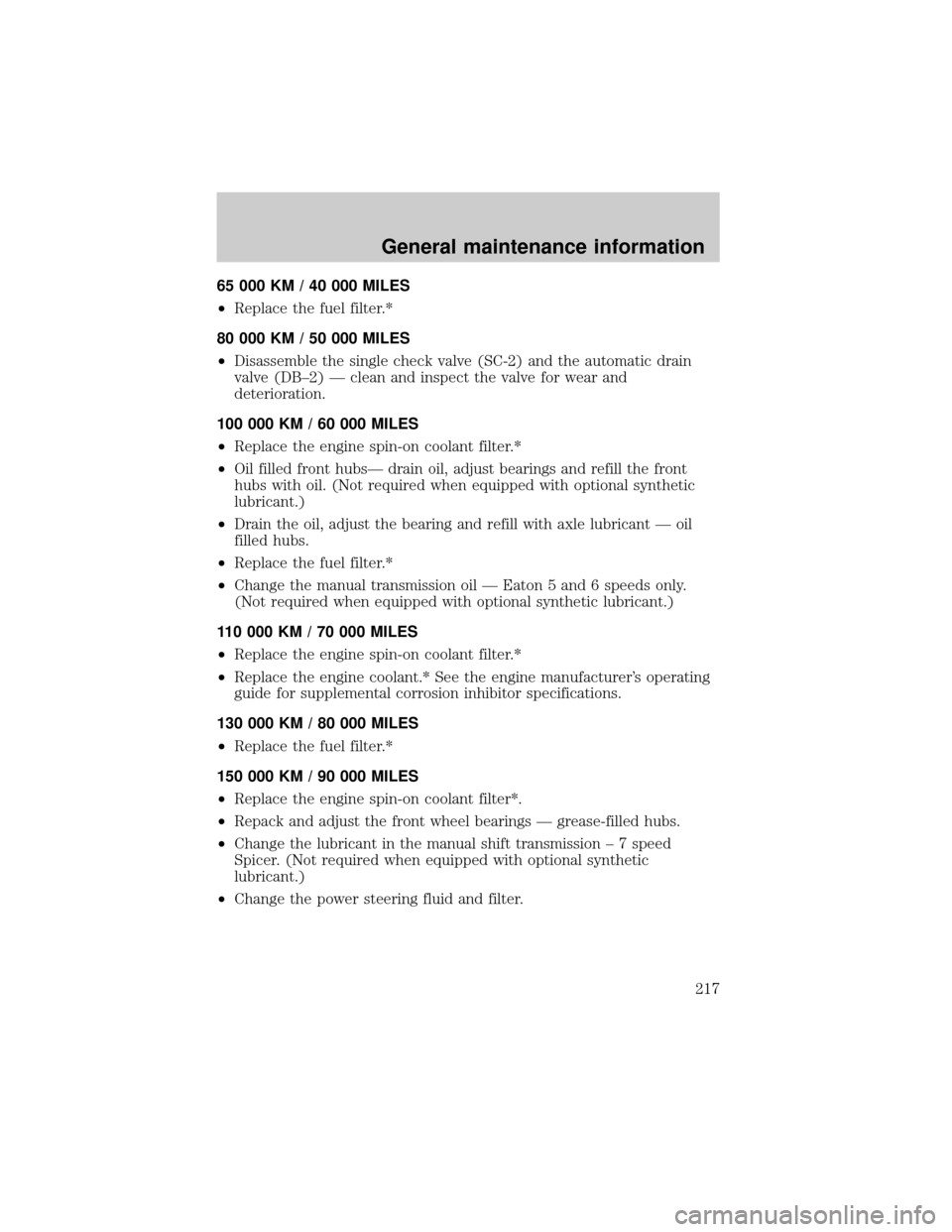
65 000 KM / 40 000 MILES
²Replace the fuel filter.*
80 000 KM / 50 000 MILES
²Disassemble the single check valve (SC-2) and the automatic drain
valve (DB±2) Ð clean and inspect the valve for wear and
deterioration.
100 000 KM / 60 000 MILES
²Replace the engine spin-on coolant filter.*
²Oil filled front hubsÐ drain oil, adjust bearings and refill the front
hubs with oil. (Not required when equipped with optional synthetic
lubricant.)
²Drain the oil, adjust the bearing and refill with axle lubricant Ð oil
filled hubs.
²Replace the fuel filter.*
²Change the manual transmission oil Ð Eaton 5 and 6 speeds only.
(Not required when equipped with optional synthetic lubricant.)
110 000 KM / 70 000 MILES
²Replace the engine spin-on coolant filter.*
²Replace the engine coolant.* See the engine manufacturer's operating
guide for supplemental corrosion inhibitor specifications.
130 000 KM / 80 000 MILES
²Replace the fuel filter.*
150 000 KM / 90 000 MILES
²Replace the engine spin-on coolant filter*.
²Repack and adjust the front wheel bearings Ð grease-filled hubs.
²Change the lubricant in the manual shift transmission ± 7 speed
Spicer. (Not required when equipped with optional synthetic
lubricant.)
²Change the power steering fluid and filter.
General maintenance information
217
Page 220 of 240
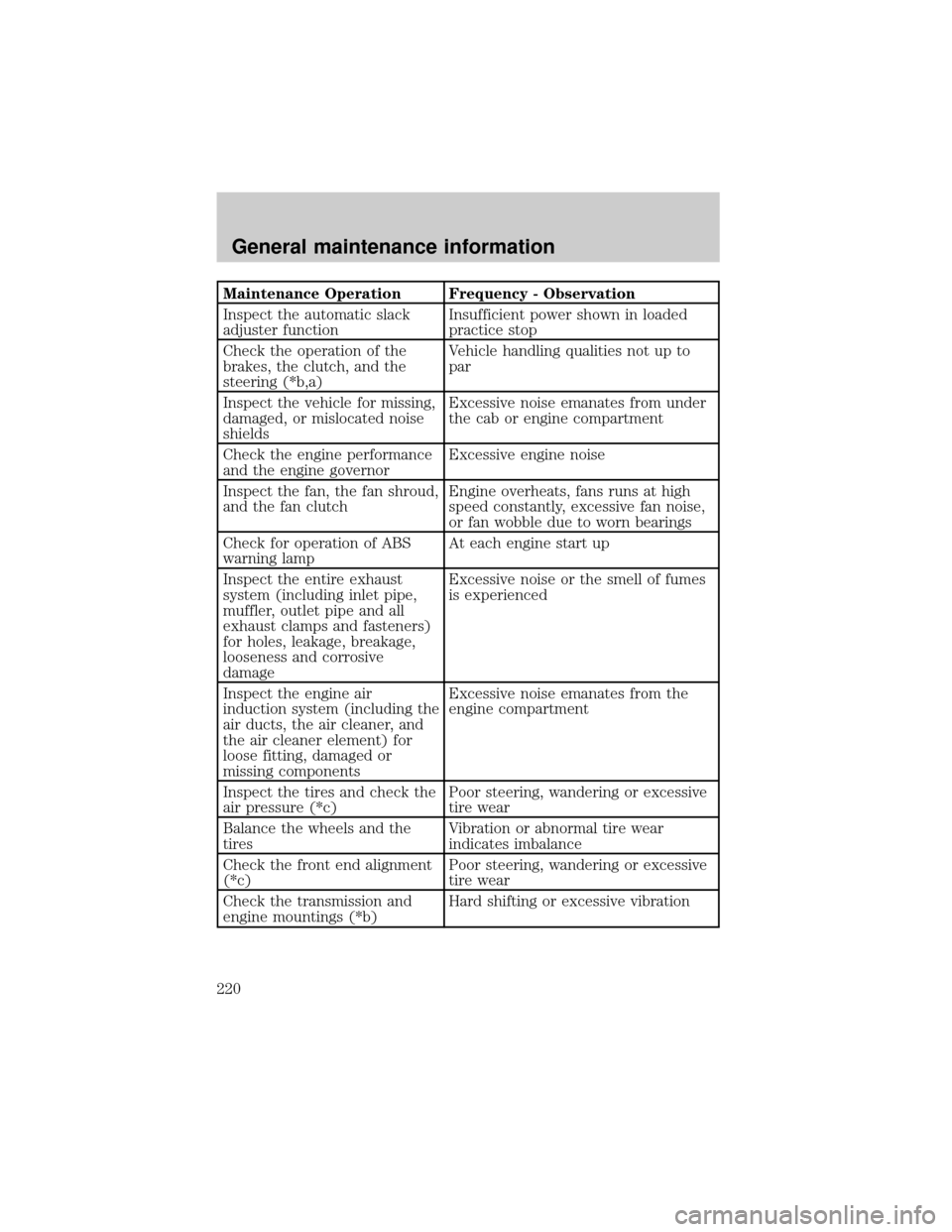
Maintenance Operation Frequency - Observation
Inspect the automatic slack
adjuster functionInsufficient power shown in loaded
practice stop
Check the operation of the
brakes, the clutch, and the
steering (*b,a)Vehicle handling qualities not up to
par
Inspect the vehicle for missing,
damaged, or mislocated noise
shieldsExcessive noise emanates from under
the cab or engine compartment
Check the engine performance
and the engine governorExcessive engine noise
Inspect the fan, the fan shroud,
and the fan clutchEngine overheats, fans runs at high
speed constantly, excessive fan noise,
or fan wobble due to worn bearings
Check for operation of ABS
warning lampAt each engine start up
Inspect the entire exhaust
system (including inlet pipe,
muffler, outlet pipe and all
exhaust clamps and fasteners)
for holes, leakage, breakage,
looseness and corrosive
damageExcessive noise or the smell of fumes
is experienced
Inspect the engine air
induction system (including the
air ducts, the air cleaner, and
the air cleaner element) for
loose fitting, damaged or
missing componentsExcessive noise emanates from the
engine compartment
Inspect the tires and check the
air pressure (*c)Poor steering, wandering or excessive
tire wear
Balance the wheels and the
tiresVibration or abnormal tire wear
indicates imbalance
Check the front end alignment
(*c)Poor steering, wandering or excessive
tire wear
Check the transmission and
engine mountings (*b)Hard shifting or excessive vibration
General maintenance information
220
Page 221 of 240
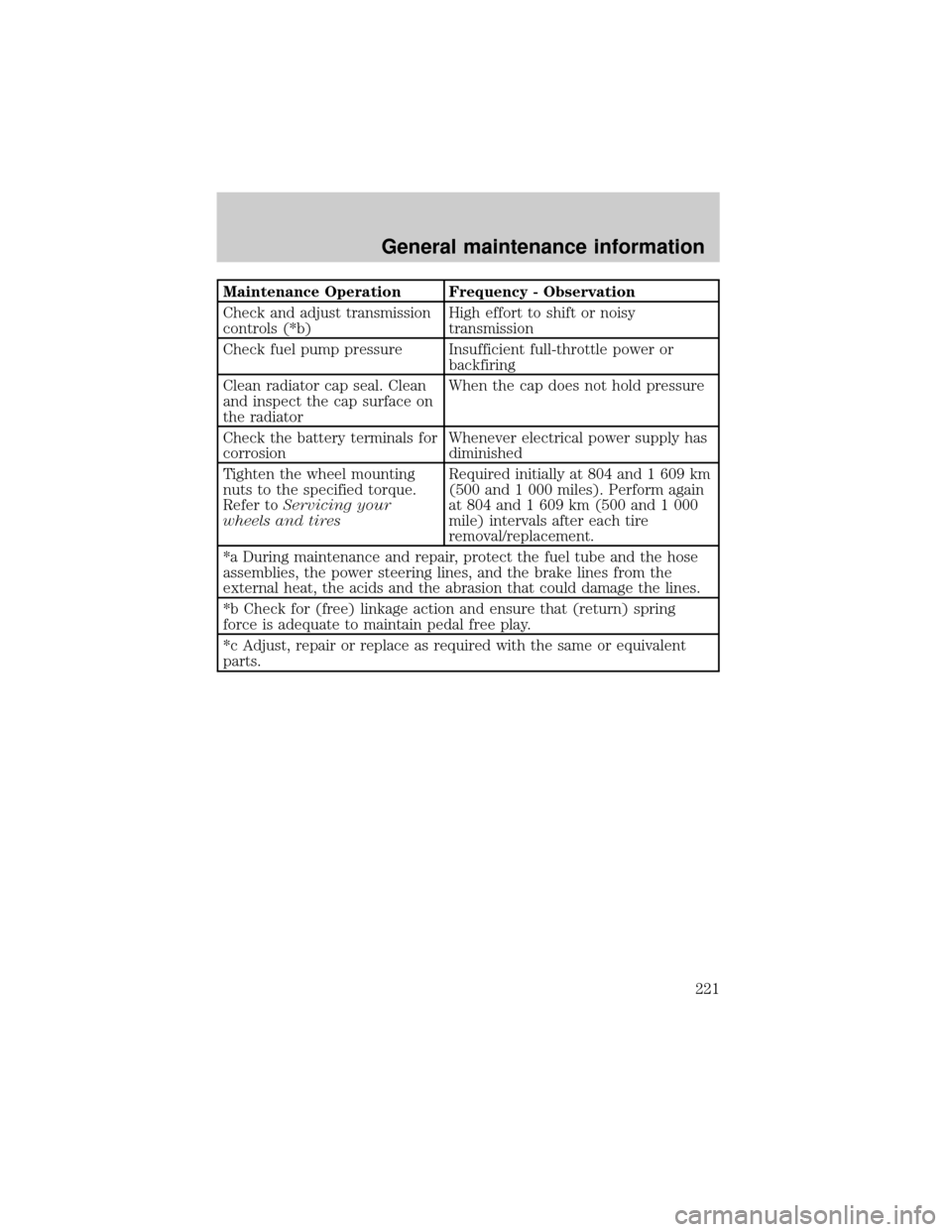
Maintenance Operation Frequency - Observation
Check and adjust transmission
controls (*b)High effort to shift or noisy
transmission
Check fuel pump pressure Insufficient full-throttle power or
backfiring
Clean radiator cap seal. Clean
and inspect the cap surface on
the radiatorWhen the cap does not hold pressure
Check the battery terminals for
corrosionWhenever electrical power supply has
diminished
Tighten the wheel mounting
nuts to the specified torque.
Refer toServicing your
wheels and tiresRequired initially at 804 and 1 609 km
(500 and 1 000 miles). Perform again
at 804 and 1 609 km (500 and 1 000
mile) intervals after each tire
removal/replacement.
*a During maintenance and repair, protect the fuel tube and the hose
assemblies, the power steering lines, and the brake lines from the
external heat, the acids and the abrasion that could damage the lines.
*b Check for (free) linkage action and ensure that (return) spring
force is adequate to maintain pedal free play.
*c Adjust, repair or replace as required with the same or equivalent
parts.
General maintenance information
221